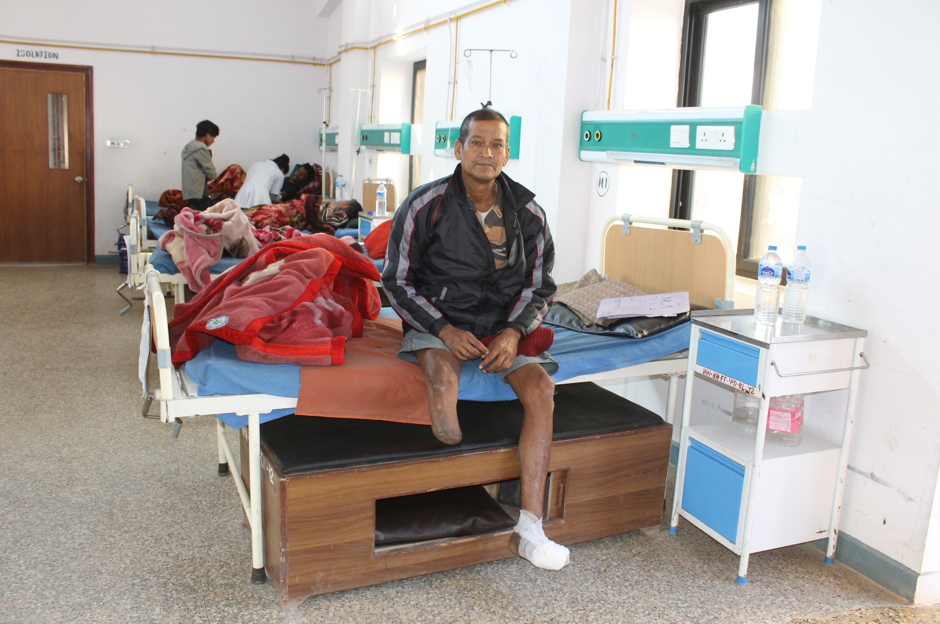Battling NCDs in rural Nepal
10th July 2018

10th July 2018
His is just one example of people living with noncommunicable diseases (NCDs) in rural Nepal, and the suffering and difficulties they face when accessing health services. They are yet another example of why NCDs need to be given global attention and priority.
There has been a rise in the number of NCDs in rural areas of Nepal. The most common ones are diabetes mellitus, hypertension and chronic obstructive pulmonary diseases (COPD). Rural Nepal faces triple challenges: a high burden of communicable diseases; a rising occurrence of NCDs, including neglected mental health; and high mortality rates for mothers and children under five.
Three decades ago, diarrheal diseases were the leading cause of death in Nepal. This has changed thanks to improvements in hygiene and sanitation - and the rise in NCDs. According to the Institute for Health Metrics and Evaluation[i] cardiovascular diseases are now the leading cause of death in both men and women in Nepal and globally.

Mr. Krishna Bohara, 47, receiving treatment for his uncontrolled blood glucose level and diabetic foot ulcer at Bayalpata Hospital in rural Nepal. (Photo: Bikash Gauchan)
There has been a rise in NCDs not only in urban areas but also in rural and impoverished settings, both in Nepal and globally. Rich and poor are affected by NCDs. However, urban areas have healthcare systems to address the medical need of NCDs, while rural areas lack necessary infrastructure (logistics and human resources) to deal with the rising burden.
Furthermore, people living in rural areas are less likely to be aware of the connections between NCDs and smoking, alcohol consumption, sedentary lifestyle and other risk factors. There are more people who smoke and are exposed to biomass in poorly ventilated rural kitchens. This may be one of the causes of COPD among females in rural Achham.
In both rural and urban areas, it is not unusual for people with NCDs start to seek healthcare only when they have complications. Such cases are difficult to manage in Nepal, especially at health facilities in rural areas. These facilities lack the infrastructure and tests to diagnose NCDs early and then provide a primary level of treatment. This can result in the progression from easily treatable conditions to those that are far more serious. For example, patients have arrived at emergency facilities with chronic kidney disease (CKD) that has developed from uncontrolled hypertension.
As a major component of Universal Health Coverage (UHC), it is essential for all countries to ensure that people living in both urban and rural areas have access to primary health care that is able to diagnose and start the early management of NCDs. This action will help to prevent complications and the high medical cost of managing them.
Primary healthcare needs to focus on public health interventions to prevent the development of NCDs. Public health experts can lead strategies and campaigns about the ways to prevent NCDs in both rural and urban areas.
Nepal is trying to implement the WHO PEN (Package of Essential Noncommunicable Diseases) interventions in low-resource settings to address the emerging needs of NCDs. These interventions are simple protocols that can be followed by mid-level health workers in health settings in resource-poor areas. Currently, PEN is being piloted in 25 districts, but because people with NCDs need to have access to comprehensive primary care in their own community, Nepal’s ministry of health needs to expand the WHO PEN interventions in all districts.
People with NCDs in rural areas often face extreme suffering due to health care systems that are unable to deal adequately with NCDs, which urges global health policy makers to seek better implementation of health programmes to deal with NCDs. There is an urgent need for better infrastructure and healthcare systems to address the rising burden of NCDs, in rural Nepal and globally.
In the far western, hilly rural region, we are providing free essential and emergency health services at Bayalpata Hospital, which is integrated with a community health program led by community health workers (CHWs). In addition to early diagnosis and management of NCDs at the hospital by clinicians, we have NCD counsellors to provide health education, tips for health promotion, and information on multiple ways to prevent complications. Among the responsibilities of our CHWs are to follow up people with NCDs in their own homes and check for their clinical adherence and improvement. CHWs are also trained to monitor blood pressure.
Bikash Gauchan was born in 1983 in Kalopani village, in the famous mountain district of Mustang, in Nepal. He completed a Bachelor of Medicine and a Bachelor of Surgery (MBBS) at B. P. Koirala Institute of Health Sciences (BPKIHS) in Dharan, Nepal. In August 2010, he joined Bayalpata Hospital as the medical director. He has a deep passion for improving the health care system in rural regions. He has been a fellow of Global Health (HEAL Initiative, https://healinitiative.org) at University of California, San Francisco (UCSF) since June 2017.